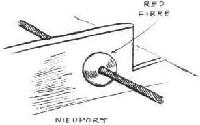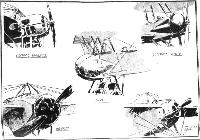L.Opdyke French Aeroplanes Before the Great War (Schiffer)
Deleted by request of (c)Schiffer Publishing
X: The 2-seat X, and the XI, were entirely different machines, both monoplanes. The XI was designed for cavalry support and dirigible interception, but they proved unsuccessful. They had untapered wings of different spans, larger elevators and simplified undercarriages.
(2-seater, passenger in front): span: 12.3 m; length: 5.8 m; wing area: 14.1 sqm; weight: 401 kg; speed; 115 kmh; 80 hp)
Показать полностью
Журнал Flight
Flight, November 9, 1912.
THE PARIS AERO SALON.
Nieuport.
FOUR machines are shown on this stand - a standard 28-h.p. Nieuport monoplane of the school type, a standard 70-h.p. two-seater, a new racing model, and a 100-h.p. "Hydravion," similar in every respect to the one that hangs suspended from the roof above the exhibit of the French Minister of War. No special description of the first two models is necessary. They are quite standard; and, for that matter, very little need be said of the latter two, for in the case of the racing model the machine is simply a smaller edition of the standard machine with changes in the chassis, and, for the Hydravion, it is but the ordinary 100-h.p. three-seater model with a float chassis instead of a wheeled one.
Let us first deal with the racing model. To attain high speed the designer has not resorted to high engine power. He has kept to the 50-h.p. Gnome, and to increase the speed has aimed at still further increasing the efficiency of the machine by cutting down head resistance.
This is chiefly noticeable in the landing gear, which, as a light construction having little head resistance, is perhaps good. But, as a landing gear, pure and simple, we doubt if anything more treacherous has ever been designed. As long as it is used only on smooth ground, it may stand up to its work all right - that is, if it were in the hands of a skilful pilot. What would happen over rough ground we dread to imagine. The chassis is all of steel, and there are only two laminations in the transverse spring.
There being no horizontal skid it is impossible to arrange the warping as heretofore. On this machine it is operated by bell cranks just below the fuselage, worked by the feet as usual. To cut down some of the head resistance of the Gnome engine, a dome is fitted over the front, a quarter segment of it being cut away to admit sufficient air for cooling. The wings only span 23 ft. and they have noticeably less curvature and incidence than previous models. They are each stayed on the underside by four cables - two to each spar.
<...>
Flight, January 3, 1914.
THE PARIS AERO SALON - 1913.
NIEUPORT.
THE Nieuport firm made an impressive show with four monoplanes and a Nieuport-built Dunne biplane. One of the machines, and not the least interesting, was the one on which Helen recently covered a distance of some 20,000 kilometres. The machine, although naturally somewhat dirty, did not seem any the worse for its constant exposure to all sorts of weather conditions, and furnished an excellent proof of the quality of the Nieuport workmanship.
Of the other machines shown, one was an armoured monoplane of the Military type, and fitted with a Hotchkiss machine gun. The front portion of the fuselage, up to just behind the seats, is covered with sheet steel, and a cowl of the same material is fitted on the propeller boss with which it revolves, so that there is very little chance of a bullet hitting any part of the engine, and thereby putting the machine out of action.
It is driven by a 14-cyl. 160 h.p. Gnome engine, mounted on double bearings. The fuselage, which is of the usual deep Nieuport section, is built up of four longerons of ash, connected by struts and cross-members of spruce.
Inside this roomy fuselage are arranged the seats for the pilot and two passengers, the pilot's seat resting on a large petrol tank in front and the passengers' seats arranged side by side behind him. The set of instruments fitted is one of the most complete seen on any of the machines at the Show. The chassis is of the usual Nieuport type, consisting of three pairs of V-struts of streamline steel tubes, which carry on their lower extremities a tubular skid, whilst springing is effected by means of a leaf spring-axle carrying the two wheels. A rocking shaft sloping down from the fuselage to a bearing behind the rear pair of chassis struts carries a crank lever, to which are attached the warping cables. On the upper end of this rocking shaft is mounted a transverse foot-bar, by means of which the wings are warped. A single tubular lever is used for operating rudder and elevator. The main planes are of the usual Nieuport section, and taper considerably towards the tip. The fixed tail plane, which is of semi-circular shape, is mounted on top of the fuselage and to its trailing edge are hinged the two elevator flaps. The rudder, which projects tome distance above the tail plane, is pivoted to a steel tube forming the stern post of the fuselage.
Of the other machines shown, one is a tandem two-seater Military monoplane, which is driven by an 80 h.p. 7-cyl. Clerget engine, mounted on double bearings in the front portion of the fuselage. This machine follows in every respect the usual Nieuport practice. The seats for the pilot and passenger are arranged tandem fashion, the passenger's seat in front being mounted on one side of the fuselage, so that he is facing towards the right-hand wing. The object of this arrangement is not quite clear, but the idea is presumably to give the pilot a more unobstructed view straight ahead. The two seats are arranged, each in its own cockpit, each occupant being protected by a wind-screen of large dimensions.
<...>
Показать полностью








